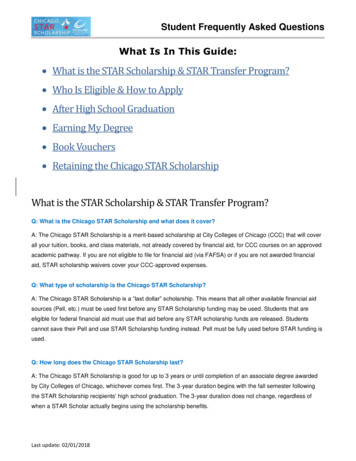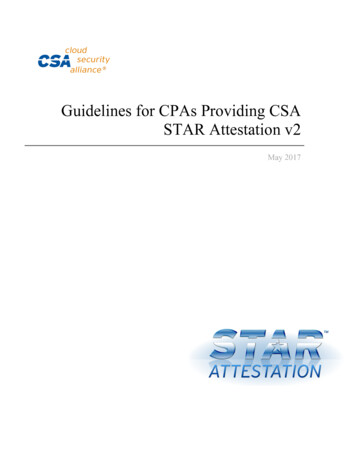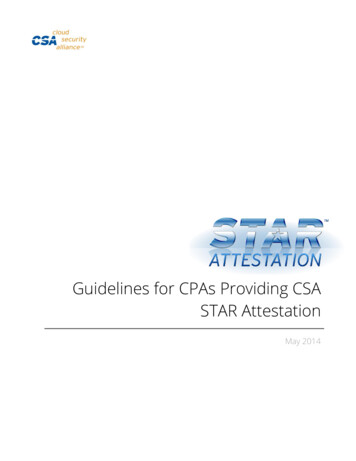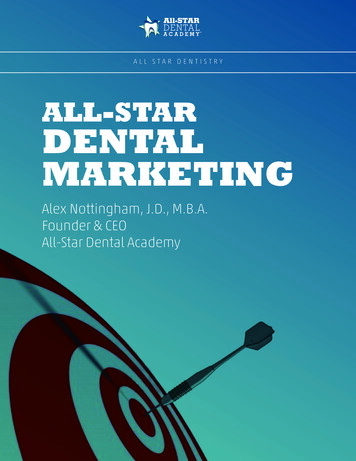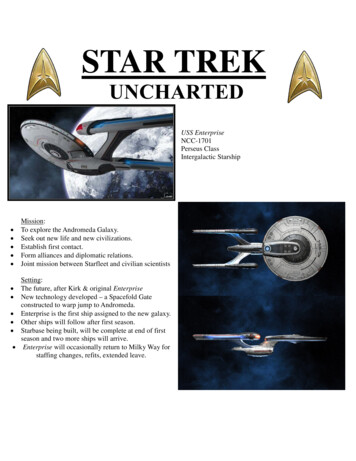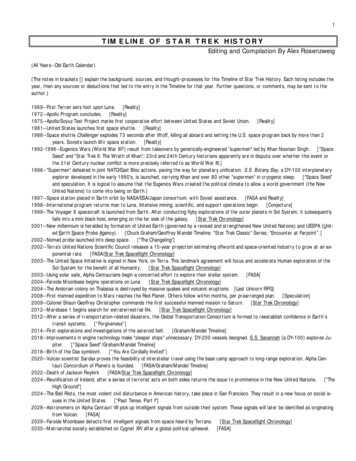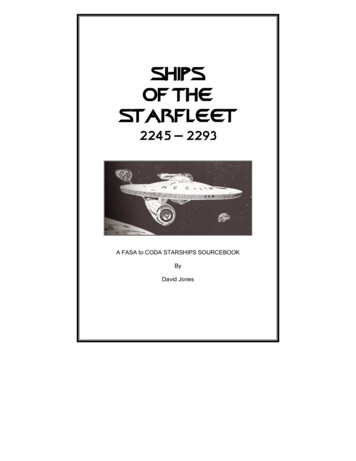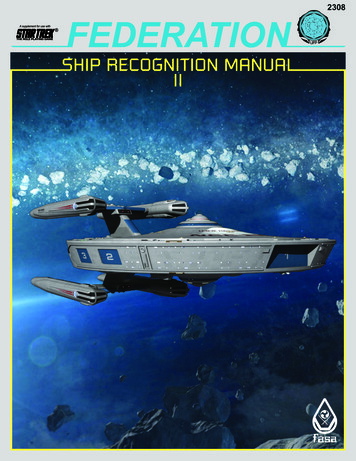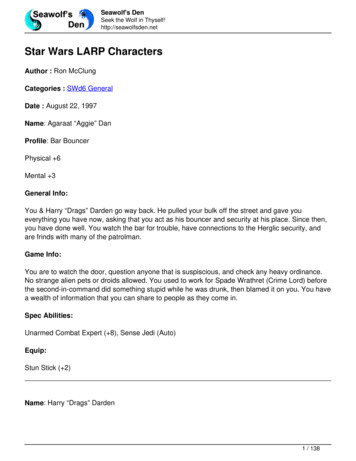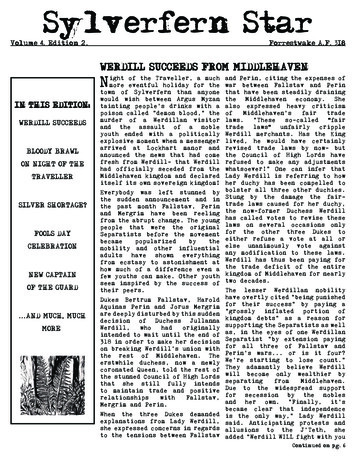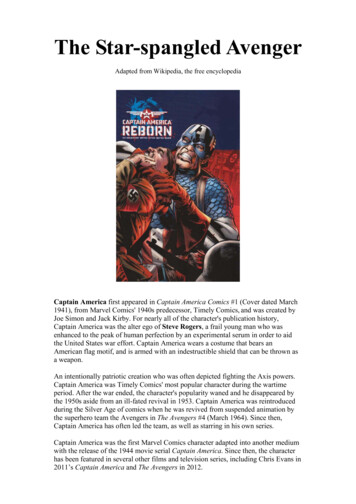
Transcription
The Star-spangled AvengerAdapted from Wikipedia, the free encyclopediaCaptain America first appeared in Captain America Comics #1 (Cover dated March1941), from Marvel Comics' 1940s predecessor, Timely Comics, and was created byJoe Simon and Jack Kirby. For nearly all of the character's publication history,Captain America was the alter ego of Steve Rogers, a frail young man who wasenhanced to the peak of human perfection by an experimental serum in order to aidthe United States war effort. Captain America wears a costume that bears anAmerican flag motif, and is armed with an indestructible shield that can be thrown asa weapon.An intentionally patriotic creation who was often depicted fighting the Axis powers.Captain America was Timely Comics' most popular character during the wartimeperiod. After the war ended, the character's popularity waned and he disappeared bythe 1950s aside from an ill-fated revival in 1953. Captain America was reintroducedduring the Silver Age of comics when he was revived from suspended animation bythe superhero team the Avengers in The Avengers #4 (March 1964). Since then,Captain America has often led the team, as well as starring in his own series.Captain America was the first Marvel Comics character adapted into another mediumwith the release of the 1944 movie serial Captain America. Since then, the characterhas been featured in several other films and television series, including Chris Evans in2011’s Captain America and The Avengers in 2012.
The creation of Captain AmericaIn 1940, writer Joe Simon conceived the idea for Captain America and made a sketchof the character in costume. "I wrote the name 'Super American' at the bottom of thepage," Simon said in his autobiography. "No, it didn't work. There were too many'Supers' around. 'Captain America' had a good sound to it. There weren't a lot ofcaptains in comics. It was as easy as that. The boy companion was simply namedBucky, after my friend Bucky Pierson, a star on our high school basketball team."Simon said Captain America was a consciously political creation; he and Jack Kirbywere morally repulsed by the actions of Nazi Germany in the years leading up to theUnited States' involvement in World War II and felt war was inevitable: "Theopponents to the war were all quite well organized. We wanted to have our say too."Captain America Comics #1 — cover-dated March 1941 and on sale in December1940, a year before the attack on Pearl Harbor but a full year into World War II —showed the protagonist punching Nazi leader Adolf Hitler in the jaw; it sold nearlyone million copies. While most readers responded favorably to the comic, some tookobjection. Simon noted, "When the first issue came out we got a lot of. threateningletters and hate mail. Some people really opposed what Cap stood for." CaptainAmerica immediately became the most prominent and enduring of that wave ofsuperheroes introduced in American comic books prior to and during World War IIWith his sidekick Bucky, Captain America faced Nazis, Japanese, and other threats towartime America and the Allies. Stanley Lieber, now better known by his pen nameStan Lee, contributed to the character in issue #3 in the filler text story "CaptainAmerica Foils the Traitor's Revenge," which introduced the character's use of hisshield as a returning throwing weapon. Captain America soon became Timely's mostpopular character and even had a fan-club called the "Sentinels of Liberty."Biography of a hero from wartime to joining theAvengers1940sSteve Rogers was born July 4, 1920, in the Lower East Side of Manhattan, New YorkCity, to Irish immigrant parents. His father died when Steve was only a child and hismother died of pneumonia while Steve was a teen. By early 1940, before America'sentry into World War II, Rogers is a tall but scrawny fine arts student specializing inillustration. Disturbed by the rise of the Third Reich Rogers attempts to enlist, only tobe rejected due to being in poor shape. U.S. Army General Chester Phillips, lookingfor test subjects, offers Rogers the chance to serve his country by taking part in a topsecret defence project — Operation: Rebirth, which seeks to develop a means ofcreating physically superior soldiers. Rogers volunteers for the research and, after arigorous selection process, is chosen as the first human test subject for the SuperSoldier serum developed by the scientist "Dr. Josef Reinstein", later retroactivelychanged to a code name for the scientist Abraham Erskine. In the 2002 miniseriesTruth, it was revealed that the Super-Soldier serum was first tested on AfricanAmerican soldiers before being given to Rogers.That night, Operation: Rebirth is implemented and Rogers receives injections and oraldoses of the Super-Soldier Serum. He is then exposed to a controlled burst of "VitaRays" that activate and stabilize the chemicals in his system. The process successfully
alters his physiology almost instantly from its relatively frail form to the maximum ofhuman efficiency, greatly enhancing his musculature, reflexes, agility, stamina andintelligence. Erskine declares Rogers to be the first of a new breed of man, a "nearlyperfect human being." The process he underwent has varied from account to account.In the original 1941 story, he was injected with the formula. When the origin wasretold in Tales of Suspense #63, the Comics Code Authority and its prohibitions ondemonstrations of drug use were in force, and the injection was replaced withdrinking a formula. In Captain America #109, the Vita-Rays were first introduced,although a dialogue comment preserved continuity by mentioning that he had alsodrunk the formula beforehand. The retelling of the story in Captain America #255,however, stated that all three were used in combination. In addition, the limited series,The Adventures of Captain America reveals that Rogers also underwent rigorousphysical training in combat prior to his enhancement.After the physical transformation, a Nazi spy reveals himself and shoots Erskinebefore being overcome by the now enhanced Rogers. Because the scientist hadcommitted crucial portions of the Super-Soldier formula to memory, duplicating itperfectly would be unlikely.The U.S. government, making the most of its one super-soldier and to hide allinformation about Operation: Rebirth and its failure, re-imagines him as a superherowho serves as both a counter-intelligence agent and a propaganda symbol to counterNazi Germany’s head of terrorist operations, the Red Skull. To that end, Rogers isgiven a uniform modeled after the American flag (based on Rogers' own sketches) abulletproof shield, a personal side arm, and the codename Captain America. He is alsogiven a cover identity as a clumsy infantry private at Camp Lehigh in Virginia. Barelyout of his teens himself, Rogers makes friends with the camp's teenage mascot, JamesBuchanan "Bucky" Barnes.Barnes accidentally learns of Rogers' dual identity and offers to keep the secret if hecan become Captain America's sidekick. Rogers agrees and trains Barnes. Rogersmeets President Roosevelt, who presents him with a new shield, forged from an alloyof steel and vibranium, fused by an unknown catalyst. The alloy is indestructible, yetthe shield is light enough to use as a discus like weapon that can be angled to return tohim. It proves so effective that Captain America forgoes the sidearm. ThroughoutWorld War II, Captain America and Bucky fight the Nazi menace both on their ownand as members of the superhero team the Invaders. Captain America also battles anumber of criminal menaces on American soil.In late April 1945, during the closing days of World War II, Captain America andBucky try to stop the villainous Baron Zemo destroying an experimental drone plane.Zemo launches the plane with an armed explosive on it, with Rogers and Barnes inhot pursuit. They reach the plane just before it takes off, but when Bucky tries todefuse the bomb, it explodes in mid-air. The young man is believed killed, and Rogersis hurled into the freezing waters of the North Atlantic. Neither body is found, andboth are presumed dead. It is later revealed that neither character actually died.Late 1940s to 1950sCaptain America continued to appear in comics for the next few years changing fromWorld War II-era hero to trying to defeat the United States' newest enemy,Communism. The revival of the character in the mid-1950s is short-lived, and events
during that time period are later retconned to show that multiple people operated asCaptain America. These successors are listed as William Naslund and Jeffrey Mace.Jeffrey Mace was so devoted to emulating Captain America that he had had hisappearance surgically altered to resemble Rogers. He came to be formally addressedas the "1950s Captain America". Furthermore, he also treated himself and a protege toan acquired Nazi copy of the Super-Soldier serum to become the new CaptainAmerica and Bucky, but were unaware of the necessary Vita-Ray component. As aresult, the raw chemicals administered began to have serious detrimental effects onthe pair's minds, rendering them both violently paranoid and regarding even innocentpeople as communist sympathizers during the height of the Red Scare of the 1950s(senator McCarthy would have been proud). After it became evident that the two wereinsane, they were captured and placed in indefinite cryogenic storage by the USGovernment until they could be cured of their mental illness. The 1950s Bucky wouldbe cured and go on to be Steve Roger’s partner for a time under the Nomad identity.1960sYears later, the superhero team the Avengers discovers Steve Rogers' body in theNorth Atlantic, the Captain's uniform under his soldier's fatigues and still carrying hisshield. After he revives, they piece together that Rogers had been preserved in a blockof ice since 1945, surviving in such a state only because of his enhancements fromOperation: Rebirth. The block had begun to melt after the Sub-Mariner, enraged thatan Inuit tribe is worshiping the frozen figure, throws it into the ocean. Rogers acceptsmembership in the Avengers, and although long out of his time, his considerablecombat experience makes him a valuable asset to the team. He quickly assumesleadership, and has typically returned to that position throughout the team's history.Captain America is plagued by guilt for having been unable to prevent Bucky'sdeath—a feeling that does not ease for some time. Although he takes the young RickJones (who closely resembles Bucky) under his tutelage, he refuses for some time toallow Jones to take up the Bucky identity, not wishing to be responsible for anotheryouth's death. Insisting that his hero finally move on from that loss, Jones eventuallyconvinces Rogers to let him don the Bucky costume, but this partnership lasts only ashort time; a disguised Red Skull, impersonating Rogers with the help of the CosmicCube, drives Jones away.Rogers also reunites with his old war ally Nick Fury, who is similarly well-preserveddue to the "Infinity Formula." As a result, Rogers regularly undertakes missions forthe security agency S.H.I.E.L.D. for which Fury is public director. Through Fury,Rogers befriends Sharon Carter, a S.H.I.E.L.D. agent, with whom he eventuallybegins a romantic relationship.Rogers later meets and trains Sam Wilson, who becomes the superhero the Falcon,one of the first African-American superheroes in mainstream comic books.Since then Cap has continued with his long and illustrious career up to the presentday.The rest, as they say is History.
Steve Rogers' presumed death during the “Civil War” storyline, 2006. Art by SteveEpting.Powers and abilitiesCaptain America has no superhuman powers, although as a result of the Super-SoldierSerum and "Vita-Ray" treatment, he is transformed from a frail young man into a"perfect" specimen of human development and conditioning. Captain America'sstrength, endurance, agility, speed, reflexes, durability, and healing are at the zenith ofnatural human potential. Rogers' body regularly replenishes the super-soldier serum; itdoes not wear off.The formula enhances all of his metabolic functions and prevents the build-up offatigue poisons in his muscles, giving him endurance far in excess of an ordinaryhuman being. This accounts for many of his extraordinary feats, including benchpressing 1200 pounds (545 kg) and running a mile (1.6 km) in 73 seconds (49 mph/78kph). Furthermore, his enhancements are the reason why he was able to survive beingfrozen in suspended animation for decades. Rogers cannot become intoxicated byalcohol, drugs, or impurities in the air and is immune to terrestrial diseases. He is alsohighly resistant to hypnosis or gases that could limit his focus. The secrets of creatinga super-soldier were lost with the death of its creator, Dr. Abraham Erskine. However,in the ensuing decades there have been numerous secret attempts to recreate Erskine'streatment, only to have them end in failure.Rogers' battle experience and training make him an expert tactician and an excellentfield commander, with his teammates frequently deferring to his orders in battle.Rogers' reflexes and senses are also extraordinarily keen. He has blended judo,western boxing, kickboxing, and gymnastics into his own unique fighting style and isa master of multiple martial arts. Years of practice with his indestructible shield makehim able to aim and throw it with almost unerring accuracy. His skill with his shield issuch that he can attack multiple targets in succession with a single throw or evencause a boomerang-like return from a throw to attack an enemy from behind. Incanon, he is regarded by other skilled fighters as one of the best hand-to-handcombatants in the Marvel Universe. Although the super-soldier serum is an importantpart of his strength, Rogers has shown himself still sufficiently capable againststronger opponents, even when the serum has been deactivated reverting him to hispre-Captain America physique.
Rogers has vast U.S. Military knowledge and is often shown to be familiar withongoing, classified Defense Department operations. He is an expert in combatstrategy, survival, acrobatics, military strategy, piloting, and demolitions. Despite hishigh profile as one of the world's most popular and recognizable superheroes, Rogersalso has a broad understanding of the espionage community, largely through hisongoing relationship with S.H.I.E.L.D. He occasionally makes forays into relativelymundane career fields, including commercial arts, comic book artistry, education(high school history), and law enforcement.Although he lacks superhuman strength, Captain America is one of the few mortalbeings who has been deemed worthy enough to wield Thor's hammer.Weapons and equipmentCaptain America uses several shields throughout his history, the most prevalent ofwhich is a nigh-indestructible disc-shaped shield made from an experimental alloy ofsteel and the fictional vibranium. The shield was cast by American metallurgist Dr.Myron MacLain, who was contracted by the U.S. government, from orders ofPresident Roosevelt to create an impenetrable substance to use for tanks during WorldWar II. This alloy was created by accident and never duplicated, although efforts toreverse-engineer it resulted in the discovery of adamantium.Captain America often uses his shield as an offensive throwing weapon. The firstinstance of Captain America's trademark ricocheting shield-toss occurs in Stan Lee’first comics writing, the two-page text story "Captain America Foils the Traitor'sRevenge" in Captain America Comics #3 (May 1941).When without his trademark shield, Captain America sometimes uses other shieldsmade from less durable metals such as steel, or even a photonic energy shielddesigned to mimic a vibranium matrix. Rogers, having relinquished his regular shieldto Barnes, carried a variant of the energy shield which can be used with either arm,and used to either block attacks or as an improvised offensive weapon able to cutthrough metal with relative ease. Much like his vibranium shield, the energy shieldcan also be thrown, including ricocheting off multiple surfaces and returning to hishand.Captain America's uniform is made of a fire-retardant material, and he wears alightweight, bulletproof "duralumin" scale armour beneath his uniform for addedprotection. Originally, Rogers' mask was a separate piece of material, but an earlyengagement had it dislodged, thus almost exposing his identity. To prevent arecurrence of the situation, Rogers modified the mask with connecting material to hisuniform, an added benefit of which was extending his armour to cover his previouslyexposed neck. As a member of the Avengers, Rogers has an Avengers priority card,which serves as a communications device.Read Captain America’s first appearance and origin in Captain America Comics # 1, (March 1941). Then read on for a retelling of the story as narrated by Cap to NickFury in Captain America # 109 (January 1969).
Adapted from Wikipedia, the free encyclopedia Captain America first appeared in Captain America Comics #1 (Cover dated March 1941), from Marvel Comics' 1940s predecessor, Timely Comics, and was created by Joe Simon and Jack Kirb
